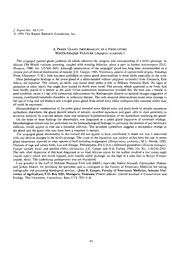
A preen gland abnormality in a free-living white-headed vulture (Aegypius occipitalis) PDF
Preview A preen gland abnormality in a free-living white-headed vulture (Aegypius occipitalis)
J Raptor Res. 30(1);45 © 1996 The Raptor Research Foundation, Inc. A Preen Gland Abnormality in a Free-living White-headed Vulture {Aegypius occipitalis) The uropygial (preen) gland produces oil which enhances the integrity and waterproofing of a bird’s plumage. In African Old World vultures, preening, coupled with sunning behavior, plays a part in feather maintenance (D.C. Houston, 1980, Ibis 122:366-369). Although examination of the uropygial gland has long been reeommended as a routine part of clinical examination of raptors (J.E. Cooper, 1985, Veterinary aspects ofcaptive birds of prey. Standfast Press, Gloucester, U.K.), little has been published on preen gland abnormalities in these birds, especially in the wild. Here pathological findings in the preen gland of a white-headed vulture {Aegypius occipitalis) from Tanzania, East Africa, are reported. The vulture, an adult, was found dead under a tree in Mikumi National Park. No signs of predation or other injury that might have caused its death were noted. The carcass, which appeared to be fresh, had been briefly placed in a freezer at the park. Gross postmortem examination revealed that the bird was a female in good condition (mass 4.5 kg) with substantial subcutaneous fat. Radiographs showed no skeletal changes suggestive of trauma, nutritional/metabolic disorders, or infectious disease. The only external abnormalities noted were damage to the tips of wing and tail feathers and a turgid preen gland from which dirty white toothpaste-like material rather than oil could be expressed. Histopathological examination of the preen gland revealed some dilated acini and ducts lined by simple, squamous epithelium; elsewhere, the gland showed whorls of keratin, stratified squamous and giant cells in close proximity to secretory material. In a seeond seetion there was moderate hyperkeratinization of the epithelium overlying the gland. On the basis of these findings the abnormality was diagnosed as a preen gland impaction of uncertain etiology. Microbiologieal culture was not performed but the histopathological findings, in particular the absence ofany heterophil infiltrate, would appear to rule out a bacterial infection. The stratified epithelium suggests a metaplastic change in the gland and the giant cells may have been a response to keratin. The uropygial gland abnormality in this vulture did not appear to have contributed to death nor was it associated with any obvious changes in the bird’s plumage. The cause of the impaction was unclear as has been the case in preen gland impactions reported in other species of bird including budgerigars {Melopsittacus undulatus; M.L. Petrak, 1982, Diseases of cage and aviary birds. Lea and Febiger, Philadelphia, PA U.S.A.), helmeted guineafowl {Numida meleagris; Cooper unpubl. data), and merlins {Falco columbarius] J.E. Cooper and N.A. Forbes, 1986, Vet. Rec. 118:232-235). The only other impaction of this kind diagnosed in an East African raptor by the author involved a live tawny eagle {Aquila rapax) which was found trapped, with heavily soiled plumage, on the edge of a soda lake in Kenya (Cooper unpubl. data). The underlying pathogenesis was not elucidated. I am grateful to the staff of Mikumi National Park and ABRU, especially Sabine Schmidt, Christopher Holmes and JoAnn Dokter, for providing the specimen, and to colleagues at the Faculty of Veterinary Medicine for taking radiographs and preparing histological sections.—John E. Cooper, Faculty of Veterinary Medicine, Sokoine Uni- versity of Agriculture, P.O. Box 3021, Morogoro, Tanzania. Present address: Durrell Institute of Conservation and Ecology, The University, Canterbury, Kent CT2 7PD U.K. 45
